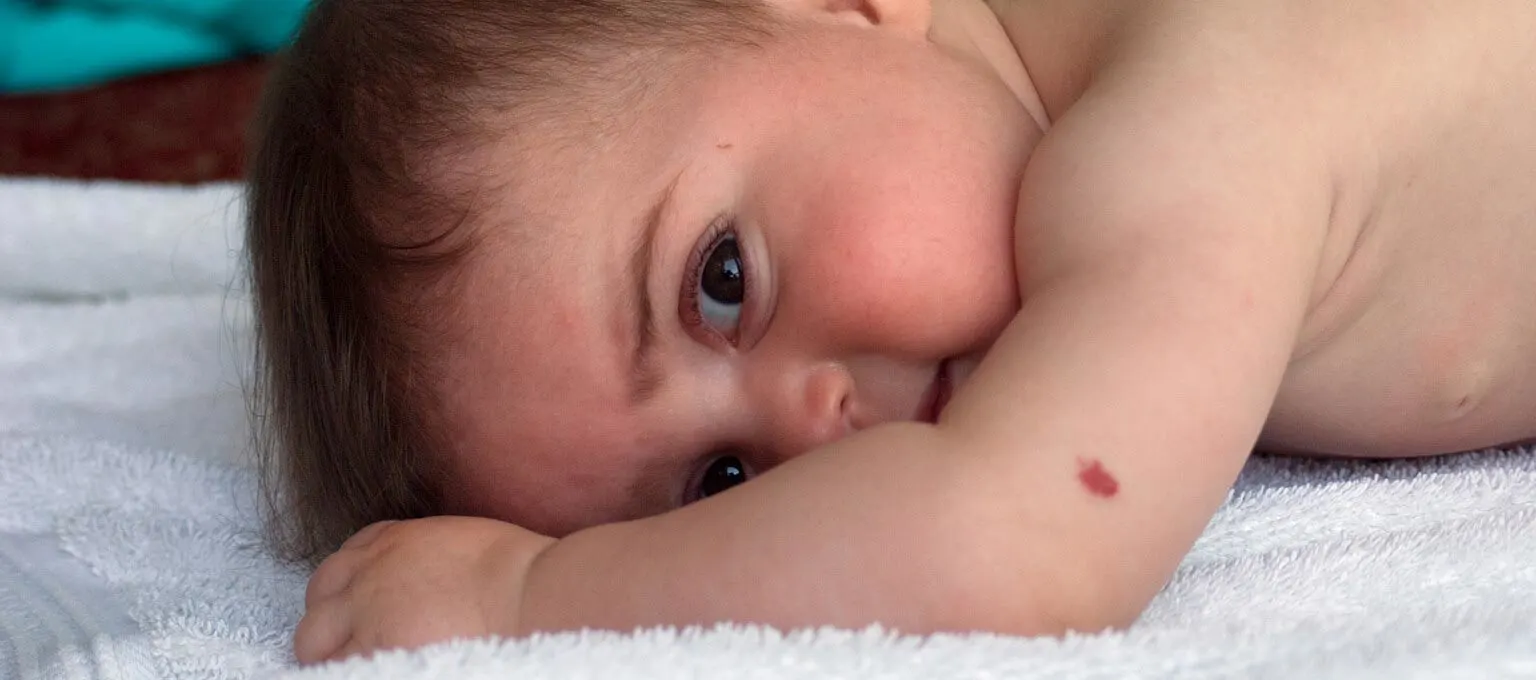What Is a Birthmark, and What Types Are There?
When you meet your newborn baby for the first time, you may notice marks on their face, head, or body. After birth, a newborn often has blotchy skin, which soon goes away, but the remaining marks could be what are known as birthmarks.
Although not all birthmarks are permanent, and many fade away in time, some birthmarks are permanent and some require medical attention. Read on to learn about some of the birthmarks your baby might be born with or develop during childhood.
What Are Birthmarks?
Just as each baby is unique, so is each birthmark. As the name suggests, birthmarks are marks that are present on your baby’s skin at birth. Some birthmarks develop before your baby is born and are visible at birth. Others are “there” but aren’t yet visible at birth and will show up sometime later.
Birthmarks can look very different from one another: Some birthmarks are flat, others are raised; some have a regular shape, and others have irregular edges. Birthmarks can come in many different colors, from tan or brown to red or blue.
Most birthmarks are harmless, and some will shrink or completely fade as your baby gets older. Rarely are birthmarks an indication of an underlying health issue. If you’re ever concerned about your baby’s birthmark(s), talk to your baby’s healthcare provider.
What Causes Birthmarks?
The cause of most birthmarks is not really known, though occasionally, birthmarks can be inherited. Nothing can be done to prevent birthmarks from appearing on your baby’s skin. They’re unrelated to any skin trauma during childbirth, and (just in case you’re wondering) they don’t occur because of something you did during pregnancy.
Types of Birthmarks
There are two main types of birthmarks in newborns:
Pigmented Birthmarks
Vascular Birthmarks
Pigmented Birthmarks
Pigmented birthmarks look brown, tan, or gray in color. This kind of birthmark forms when a higher concentration of cells produces skin color in the area.
The following are all common types of pigmented birthmarks:
Café-au-Lait Spots
Named after the French term for coffee with milk, these light tan or brown oval spots are typically present on your baby’s skin at birth or may develop in their first few years.
If a baby has just a few café-au-lait spots, it’s typically nothing to worry about. However, the presence of several spots larger than a quarter may indicate neurofibromatosis, a genetic condition that causes abnormal nerve cell growth.
A large café-au-lait spot with irregular edges may link to a rare genetic condition called McCune-Albright syndrome.
Have your healthcare provider check the spots if you’re concerned.
Dermal Melanocytosis (Mongolian Spots)
More commonly known as Mongolian spots, these birthmarks can come in various sizes, are flat, and can look brown, gray, or even blue like a bruise.
Dermal melanocytosis birthmarks are usually on your baby’s lower back or bottom. These kinds of birthmarks are very common in babies with darker skin. If your baby has one of these, it will usually fade before your little one turns school-age.
Nevi (Moles)
More commonly known as moles, nevi can be present when your baby is born or can appear later. The size of nevi may grow with your child.
These moles can range in color from tan to black. Nevi are relatively common—about 1 percent of newborns are born with nevi.
Although nevi are mostly harmless, they can sometimes develop into a type of skin cancer called melanoma at a much later time in your child’s life. Having your child’s moles periodically checked by your healthcare provider is a good idea. Let your provider know if you notice that a mole changes in appearance.
Very rarely, nevi grow larger than 20 centimeters (about 8 inches) in diameter. This only happens in about 1 in 20,000 babies. These can be flat or raised and may have hair. Your healthcare provider will check these kinds of nevi and recommend what action to take, if any.
Vascular Birthmarks
Extra blood vessels cause vascular birthmarks. The higher concentration of blood vessels in that specific area causes the birthmark to appear red or even purple.
These types of birthmarks may be flat or raised. These are all common types of vascular birthmarks:
Infantile Hemangiomas (Strawberry Birthmarks)
Commonly called strawberry birthmarks, hemangiomas result from a collection of blood vessels under the skin.
At your baby’s birth, these marks may go unnoticed. In the first weeks, they might appear pale or even white before turning red. Strawberry birthmarks occur in about 10 percent of babies by 2 months of age; most appear by 2 or 3 weeks of age.
This birthmark can appear anywhere, though most typically on your baby’s head or neck. It’s much more common in Caucasians, girls, twins, premature babies, and low-birth-weight babies.
Hemangiomas often get bigger as your baby ages, with a mark reaching its biggest size by the time your baby is about 3 months old or 4 months old. These birthmarks slowly disappear by the time your child reaches school age.
If you’re worried about your baby’s hemangioma, have your healthcare provider examine it. Hemangiomas don’t generally require treatment, but sometimes a hemangioma may need to be removed if it causes impairment—for example, if it’s close to your baby’s eye or inside their mouth or throat. It may also need to be removed if it bleeds or becomes infected.
Most children will have just one hemangioma. In rare cases, a child may have hundreds of hemangiomas scattered over their body. There may even be a hemangioma deep under their skin.
In this case, your healthcare provider may suggest treatment with a topical medication, oral medication, injection, laser treatment, or surgery. Your healthcare provider will discuss all your options with you.
Nevus Simplex
Also known as salmon patches, stork bites, or angel kisses, these birthmarks appear as pink patches on your baby’s neck, forehead, upper eyelids, nose, or upper lip.
These are very common and occur in more than 80 percent of babies. These birthmarks are most common in light-skinned babies. Salmon patches normally fade in the first few years.
Port Wine Stains
These birthmarks are large, flat, irregular-shaped dark red or purple areas on your baby’s face or neck. They’re caused by abnormalities in the blood vessels under that specific area of skin. This type of birthmark does not usually fade but instead darkens over time. Port wine stains do not disappear without treatment.
Some parents consider pulsed dye laser treatment for their children to lessen the chance of the port wine stain darkening in adolescence and adulthood. You may want to consult with your healthcare provider to learn more about your treatment options.
When a port wine stain is near the eye, forehead, or scalp, it may be a sign of an abnormality of the eye and brain called Sturge-Weber syndrome, a very rare neurological disorder associated with glaucoma, seizures, developmental delays, and learning disabilities.
Your baby’s healthcare provider can diagnose the condition and recommend treatment, which may include lasers to lighten the birthmark.
The Bottom Line
Although your healthcare provider may observe some types of birthmarks over time or recommend treatment, most birthmarks are completely harmless, and some even fade within a few years.
If you’re ever worried about a certain birthmark — its size or shape, or its unusual appearance — turn to your healthcare provider for advice. Above all, remember that, like freckles, hair color, and the shape of your little one’s nose, birthmarks are just another way in which your little one is unique.
Taking care of your baby’s skin is an important part of their daily care. Turn all those diapers and wipes into rewards by downloading the Pampers Club app and start earning today.
How We Wrote This Article The information in this article is based on the expert advice found in trusted medical and government sources, such as the American Academy of Pediatrics and the American College of Obstetricians and Gynecologists. You can find a full list of sources used for this article below. The content on this page should not replace professional medical advice. Always consult medical professionals for full diagnosis and treatment.
Join a World of Support
through Pregnancy and Parenthood.
TRACK WITH TOOLS
LEARN WITH EXPERTS
GET REWARDED












